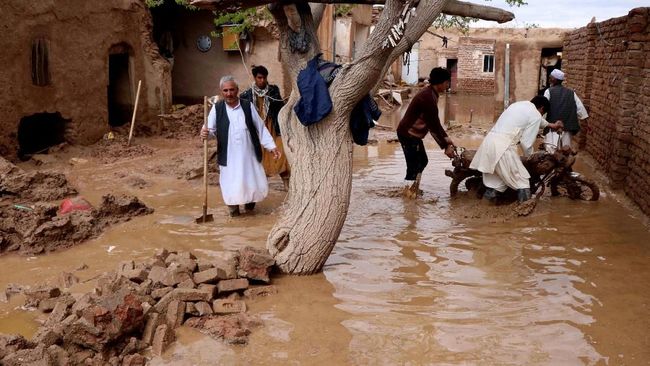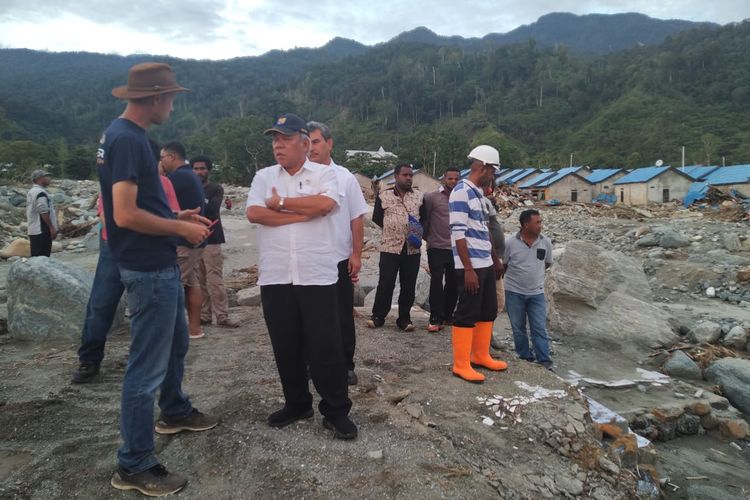:strip_icc():format(jpeg)/kly-media-production/medias/2768621/original/029984100_1554329397-banjir_iran.jpg)
Khuzestan - Ratusan ribu warga dari lusinan desa dan kota telah dievakuasi di Iran selatan ketika pihak berwenang mengeluarkan peringatan untuk babak baru banjir di wilayah yang berbatasan dengan Irak, rumah bagi sejumlah sungai dan bendungan.
Banjir terus-menerus yang dimulai sejak Maret 2019 sejauh ini telah merenggut 70 nyawa, menghancurkan infrastruktur dan ribuan orang terlantar di Iran, demikian seperti dikutip dari Al Jazeera, Minggu (7/4/2019).
Pada Sabtu 6 April 2019, Irak secara resmi menutup perbatasan Chazabeh, setelah pemerintah Iran melarang perjalanan dan perdagangan melalui perbatasan di tengah peringatan banjir di provinsi Khuzestan, Iran selatan.
Otoritas pabean Khuzestan telah meminta perusahaan perdagangan pada hari Rabu untuk menggunakan perbatasan lain yang melintasi selatan sebagai pengganti, kantor berita Iran, IRNA melaporkan.
Jalan transit ke perbatasan melewati tanah di sekitar sungai Karkheh diperkirakan membawa air banjir, karena pihak berwenang memerintahkan pembuangan darurat di bendungannya untuk mengurangi tekanan air.
Khuzestan memiliki tiga sungai besar yang melewati beberapa desa, kecamatan dan kota, termasuk Sungai Karoun yang memotong ibukota provinsi Ahvaz.
Menteri Dalam Negeri Iran, Abdoreza Rahmani Fazli mengatakan banjir mungkin mempengaruhi sekitar 400.000 orang di Khuzestan dari lebih dari 4,7 juta penduduk provinsi. Ia telah mengimbau agar warga yang terdampak untuk mengungsi.
Hujan deras juga diperkirakan terjadi di provinsi timur laut, termasuk kota Mashhad.
Infrastruktur Rusak
Banjir bandang baru-baru ini juga membaut ribuan orang mengungsi, serta memicu kekacauan dan kepanikan di Provinsi Lorestan bagian barat.
Kota Poldokhtar menanggung beban terberat dari bencana itu, tetapi air banjir juga merendam rumah-rumah di banyak desa lain di provinsi itu, sementara infrastruktur yang hancur memperlambat upaya bantuan darurat.
Wakil Menteri Jalan dan Pengembangan Kota Abdolhashem Hassannia pada hari Sabtu mengatakan jalan menuju 275 desa di provinsi itu diblokir.
"Selama banjir, 200 jembatan dan 400 kilometer jalan dihancurkan 100 persen," kata Kantor Berita Buruh Iran (ILNA) mengutip pernyataan Hassannia.
Perwakilan Lorestan di Parlemen, Mohammadreza Malekshahi, mengatakan banyak warga yang meninggalkan rumah mereka karena banjir tidak memiliki tempat untuk tidur.
"Tingkat kerusakan yang disebabkan oleh banjir baru-baru ini belum pernah terjadi sebelumnya selama abad yang lalu," katanya mengutip ILNA.



:strip_icc():format(jpeg)/kly-media-production/medias/2768621/original/029984100_1554329397-banjir_iran.jpg)

